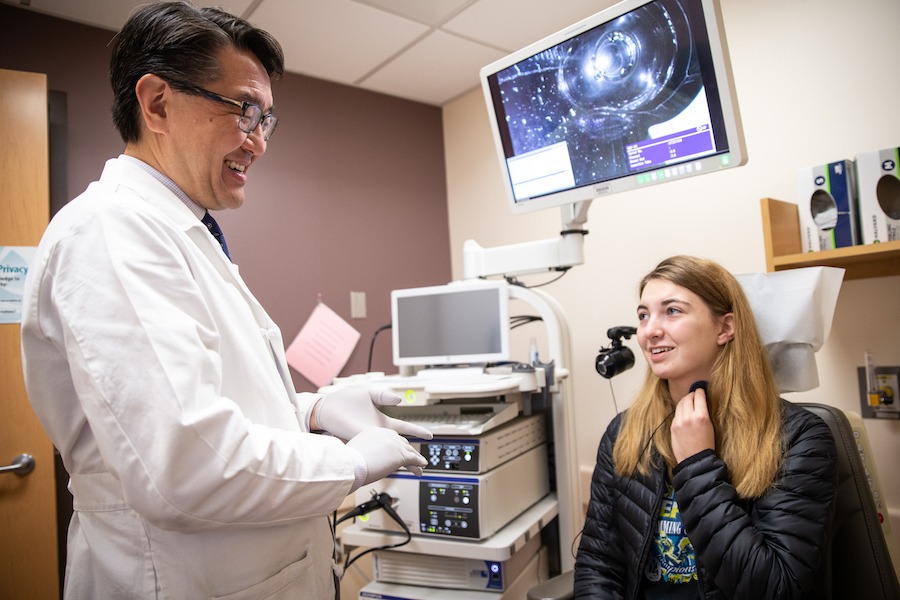Is It Safe to Sing Right Now? A Voice Expert Explains the Risk

Back in early March, when coronavirus still seemed a distant problem, 61 members of a Washington state chorus met for practice. One among them unknowingly had COVID-19. Just days later, 52 of the remaining 60 singers (or 86.7%) fell ill. Three became hospitalized, and two later died. This well-documented super spreader event showed just how effectively singing could spread COVID-19—and that practices and performances would need to go on indefinite hold.
“It was a big wake up call for everyone,” says Phillip C. Song, MD, director of the Mass. Eye and Ear Division of Laryngology and an advisor to the Boston Lyric Opera. “The whole performance world froze in their tracks and there was a moment of realization that this is not normal.” As a laryngologist, Dr. Song specializes in conditions affecting the larynx, or voice box. As COVID-19 has brought performative singing to a halt, here’s how the two are interlinked—and Dr. Song’s predictions for what may happen next.

Dr. Song works with a patient pre-COVID.
How Singing Can Spread COVID-19
When people vocalize, the rush of air through the respiratory system generates aerosols and particulates. While it’s still somewhat unclear how the size and dispersal of the droplets affect COVID-19 transmission, the way singers produce sound may spread more droplets over a larger distance.
“A lot of particulates are actually made in the lower respiratory tract, in the small air tubes called bronchioles,” Dr. Song says. “Singers are pulling in a lot more air stream through these smaller bronchioles and theoretically that might be one of the reasons why we’re seeing these super spreader events during choruses.”
In a cruel twist, contracting COVID-19 can have particularly devastating effects for singers. If a case leads to acute respiratory distress syndrome, the lungs begin to fill with blood and fluid that then scar and fibrose. “Those folks may feel these effects for the rest of their lives,” Dr. Song says. Patients are reporting reduced lung capacity after milder COVID-19 cases, too. “Even months afterward, they don’t feel like they’re at full strength,” Dr. Song says.
How Groups Can Make Singing Safer
With the potential dangers in mind, many musical groups have put practices and shows on hold. To bring them back, performers will have to reconsider how they gather. Traditional venues—like a choir practicing side-by-side in a church basement or a cast crowded together backstage—may add undue risk.
“The environment, social distancing, and adequate airflow really do matter,” Dr. Song says. “A lot of the remediation strategies for rehearsals and performances involve outdoor space and making sure they have enhanced ventilation.” He predicts alfresco performances could prove a safer alternative to indoor events as a potential next step.
In the meantime, Dr. Song and his colleague, Benjamin S. Bleier, MD, FACS, and many other researchers at Mass Eye and Ear are actively engaged in ways to reduce the spread of COVID-19 and have started studying aerosol production during different tasks. “One of the things that we’d like to do is measure particulates from singers and see the amount that they generate and how far they go,” says Dr. Song.
How and When Performances Can Return
While more research will help inform the return of performances, it’s not the only answer. “It’s really more about controlling what’s happening in the population more than anything else,” Dr. Song says. “If we can get the prevalence down, then it reduces the risk for everybody.” For example, lower case rates in Europe enabled the return of the Salzburg Festival in August 2020—and hopefully, concerts will eventually resume stateside too.
“Performers are a very, very creative and very, very resilient population of people,” Dr. Song says. “There’s going to be a pathway to getting back out there. It might not look the same as it did a year ago, but the world needs art and the world needs music.”
To learn more about the Laryngology Department at Mass Eye and Ear, where they treat disorders of the voice box and upper airway, or to schedule an appointment with a laryngologist, visit MassEyeAndEar.org or call 617-573-3954. Currently, many services and specialties are also offering virtual appointments for new and established patients. For more information, visit MassEyeAndEar.org/virtual-visits.
This is a paid partnership between Massachusetts Eye and Ear and Boston Magazine


